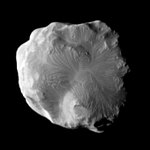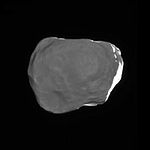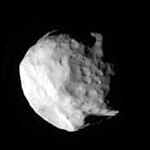Helene (moon)
 | |
| Discovery [1] | |
|---|---|
| Discovered by | |
| Discovery site | Pic du Midi Observatory |
| Discovery date | March 1, 1980 |
| Designations | |
Designation | Saturn XII |
| Pronunciation | /ˈhɛlɪniː/[2] |
Named after | Helen of Troy (Ἑλένη Helenē) |
| |
| Adjectives | Helenean /hɛlɪˈniːən/[3] |
| Orbital characteristics | |
| 377396 km | |
| Eccentricity | 0.0022 |
| 2.736915 d [4] | |
| Inclination | 0.199° (to Saturn's equator) |
| Satellite of | Saturn |
| Group | L4 Dione trojan |
| Physical characteristics | |
| Dimensions | 43.4 × 38.2 × 26 km [5] |
Mean radius | 17.6±0.4 km [5] |
| Albedo | 1.67±0.20 (geometric) [6] |
Helene /ˈhɛlɪniː/ is a moon of Saturn. It was discovered by and in 1980 from ground-based observations at Pic du Midi Observatory,[1] and was designated S/1980 S 6.[7] In 1988 it was officially named after Helen of Troy, who was the granddaughter of Cronus (Saturn) in Greek mythology.[8] Helene is also designated Saturn XII (12), which it was given in 1982, and Dione B,[9] because it is co-orbital with Dione and located in its leading Lagrangian point (L4). It is one of four known trojan moons.

Polydeuces · Helene · Dione · Saturn
Exploration[]
Helene was initially observed from Earth in 1980,[7] and Voyager flybys of Saturn in the early 1980s allowed much closer views. The Cassini–Huygens mission, which went into orbit around Saturn in 2004, provided still better views, and allowed more in-depth analysis of Helene, including views of the surface under different lighting conditions. Some of the closest images of Helene to date are from the Cassini spacecraft's 1800 km flyby on March 3, 2010, and another very successful imaging sequence occurred in June 2011. There have been many other approaches over the course of the Cassini mission.
Geology[]
Images of Helene taken by the Cassini spacecraft, with resolutions of up to 42 meters per pixel, show a landscape characterized by broad 2-10km scale depressions with interior slopes no greater than 12°. These basins are likely the decayed remains of old impact craters.[10]
Thin, elongated km-scale raised grooves trace the slopes of many of Helene's basins, and likely represent mass flow features, indicating that the moon is undergoing active geologic processes such as mass-wasting and erosion. Digital elevation models suggest that the grooves have a positive relief of between 50 and 100 meters.
Simulation models show that the time series of surface activity on Helene is chaotic.
Surface material[]
Helene's surface material is of a relatively high reflectance, suggesting grain sizes between 1 and 100 micrometers. Small craters appear somewhat buried, suggesting recent accretional processes of some sort.
Stress-strain laboratory testing of impact-gardened lunar regolith samples show that at low packing densities they behave like Non-Newtonian “Bingham” materials, i.e., having the plastic quality of candle-wax and glaciers. This observation suggests that Helene's snow-like surface material may behave as a non-Newtonian mass flow and could be primarily responsible for the visible flow patterns seen on its low-gravity surface.[10]
Selected observations[]
Mostly raw greyscale images with near infrared or ultraviolet channels.
 Cassini image of Helene against the backdrop of Saturn's clouds (March 3, 2010) |
 Flow-like features on Helene's leading hemisphere (Cassini, January 2011) |
 Helene's Saturn-facing side, lit by saturnshine (Cassini, March 2010) |
 Close-up of Helene with Saturn in the background (Cassini, March 2010) |
 Cassini image from March 3, 2010 |
 Cassini orbiter image from November 2008 |
 Cassini image taken July 2007 |
 Voyager 2 image (August 1981) |
References[]
- ^ Jump up to: a b Lecacheux1980.
- ^ John Walker (1839) A Critical Pronouncing Dictionary and Expositor of the English Language;
also per "Helena". Oxford English Dictionary (Online ed.). Oxford University Press. (Subscription or participating institution membership required.) - ^ Clarified as Helenéan in Earle (1841) Marathon: and other poems, p. 76.
- ^ NASA Celestia Archived March 9, 2005, at the Wayback Machine
- ^ Jump up to: a b Thomas 2010.
- ^ Verbiscer French et al. 2007.
- ^ Jump up to: a b IAUC 3496.
- ^ IAUC 4609.
- ^ Transactions of the International Astronomical Union, Vol. XVIIIA, 1982 (mentioned in IAUC 3872: Satellites of Jupiter and Saturn, September 30, 1983
- ^ Jump up to: a b O. M. Umurhan, A. D. Howard, J. M. Moore, P. Schenk and O. L. White (2015). "Reconstructing Helene's Surface History - Plastics and Snow" 46th Lunar and Planetary Science Conference. Retrieved 2021-02-12.
Sources
- Lecacheux, Jean. (July 1980). "A new satellite of Saturn: Dione B". Icarus. 43 (1): 111–115. Bibcode:1980Icar...43..111L. doi:10.1016/0019-1035(80)90093-7.
- Marsden, Brian G. (July 31, 1980). "Satellites of Saturn" (discovery). IAU Circular. 3496. Retrieved 2011-12-23.
- Marsden, Brian G. (September 30, 1983). "Satellites of Jupiter and Saturn". IAU Circular. 3872. Retrieved 2011-12-23.
- Marsden, Brian G. (June 8, 1988). "Satellites of Saturn and Uranus" (naming). IAU Circular. 4609. Retrieved 2011-12-23.
- Thomas, P. C. (July 2010). "Sizes, shapes, and derived properties of the saturnian satellites after the Cassini nominal mission" (PDF). Icarus. 208 (1): 395–401. Bibcode:2010Icar..208..395T. doi:10.1016/j.icarus.2010.01.025.
- Verbiscer, A.; French, R.; Showalter, M.; Helfenstein, P. (9 February 2007). "Enceladus: Cosmic Graffiti Artist Caught in the Act". Science. 315 (5813): 815. Bibcode:2007Sci...315..815V. doi:10.1126/science.1134681. PMID 17289992. (supporting online material, table S1)
External links[]
| Wikimedia Commons has media related to Helene. |
- Helene Profile by NASA's Solar System Exploration; see instead Cassini Solstice Mission: Helene
- The Planetary Society: Helene
- Helene has two faces—The Planetary Society : Helene Mini Atlas—Mar. 11, 2010
- Cassini catches Helene—The Planetary Society : Video & Views—Jun. 20, 2011
- Moons of Saturn
- Trojan moons
- Astronomical objects discovered in 1980
